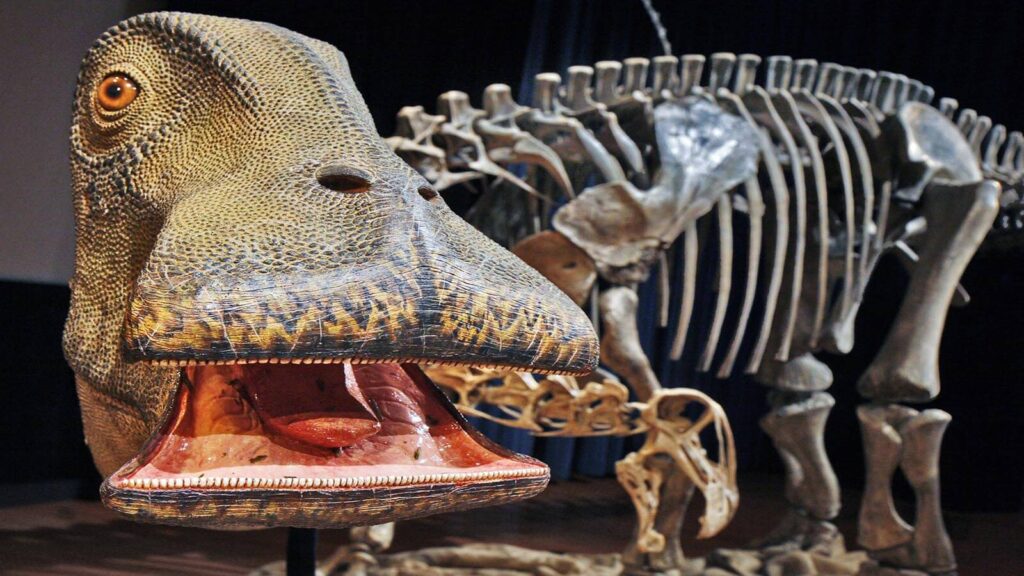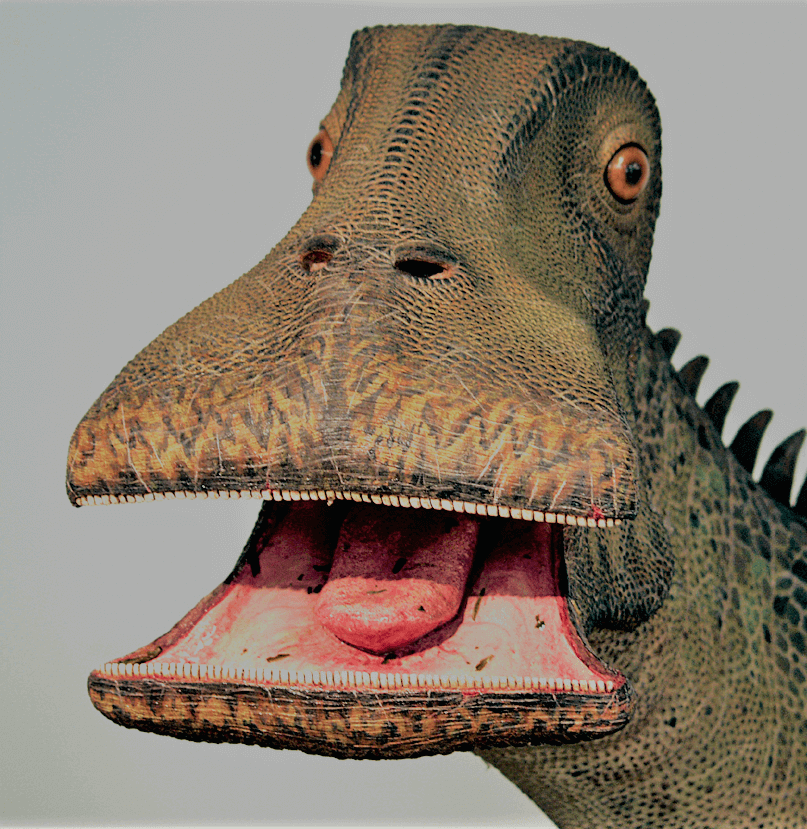What Dinosaur Has 500 Teeth? 🦕🦷 [Know Everything About Nigersaurus]

What dinosaur has 500 teeth?
- The 29-foot-long Nigersaurus was a plant-eating dinosaur that existed 112.4 million years ago in a desert of present-day Niger.
- Along with other predatory dinosaur species like Supercroc, Nigersaurus thrived in a green verdant environment.
- Nigersaurus had a delicate skull-mouth structure that was incredibly broad, lined with teeth tailor-made for ground-level plant hunting.
- One of its most distinguishing traits is the enormous, straight-edged muzzle of this bizarre, long-necked dinosaur, which is capped with more than five hundred replaceable teeth. Yeah, it’s that dinosaur with 500 teeth.
- Nigersaurus is quite significant in the literature as its skull fossils are amongst the first ones to help us digitally reconstruct dinosaurs.

You just heard about a dinosaur with 500 teeth and you can’t believe that, right?
Well in the times of dinosaurs, everything was just uncanny. In fact, the current human bodies and intellect had a far different story than dinosaurs, which Charles Darwin finally grasped and told us.
We tend to think from our own perspective so Dinosaurs appeared as creatures of just another world.
This unusual dinosaur with 500 teeth was an amazingly pretty predator with much more astonishing than only a zillion teeth. Like most of the other distinct marvels, they also inhabited Africa and its proximities. It is one of the most commonly found vertebrates in the formation.
So, you must be curious about so many things, and we are going to delve into everything.
Who Discovered Nigersaurus and How?
Phillippe Taquet (https://en.wikipedia.org/wiki/Philippe_Taquet), a French paleontologist, published the first description of Nigersaurus in one of his research articles in 1976.
He discovered their teeth for the first time between 1965 and 1972. But as there was no complete skeleton known to anyone, the finding was largely ignored. By then, even the first dinosaur skulls of this creature were not discovered.
His discovery is the reason why this dinosaur has 500 teeth and is also called Nigersaurus taqueti.
What was the Role of Sereno in the model reconstruction of Nigersaurus?

Then, later in 1999, an American paleontologist Paul Sereno made a trip to Niger. He was the one who got his hands on all the bones of this mammoth long-necked dinosaur and ultimately helped us reach a digitally reconstructed skeleton of this weirdest dinosaur.
Brazil also revealed some key fossils related to this dinosaur with 500 teeth. How it managed to reach there, they are only speculations about this questions.
Sereno and one of his friends released a study on this dinosaur with 500 teeth in 2007. They brought forward a model of the Nigersaurus skull which is now available in the national museum in Washington.
Do we have fossils of all the body parts of the Nigersaurus?
No. A complete fossil set of Nigersaurus is yet to be discovered, and we await that anxiously.
That’s why its model reconstruction was just too difficult to make a precise animal. It really required some in-depth research to be sure about its whole structure.
At what place on earth did Nigersaurus live?
They lived in the Republic of Niger’s Gadoufaoua, today the Republic of the Niger. A county in West Africa.
It’s some 100 million years ago, during the Micro-Cretaceous time, this area was a floodplain.
Actually, they had wonderfully equally spaced 500 teeth that functioned just like a comb. They would strain any available flamingos-like invertebrates or water plants.
Had they been high-browsing animals, their teeth won’t have been that parallel and the grip won’t have been the same.
Why Nigersaurus looked strange?
They had a 1-meter femur and were about 29 feet tall. Their weight, according to some credible paleontologists, must have been 4 tons.
As a result, a Nigersaurus might have been as big and heavy as an elephant today. Due to its bodily composition, it had thirteen necks in its spine and a relatively small head. So technically, it was a long necked dinosaur.
Why did Nigersaurus Chew food softly?
As their teeth didn’t have spikes and were quite plain, they couldn’t chew food with hard impact. That’s why they always lived on softer sources of food.
They ate slowly and chewed food only softly. That seems a bit unreal for the giants like dinosaurs but that’s true. Actually, the very same quality of Nigersaurus, the short even spaces between the teeth indicates that they browsed low.
How did the neck of Nigersaurus look like?
Opposite to his short-necked family members, Nigersaurus was long-necked Dinosaurs. They extended some good 34.5 feet from their small heads up to the main body.
With 66.5 degrees of a bent and wide projecting muzzle with those tiny parallel teeth, it just looked like a lawnmower.
Why was this mammoth dinosaur with 500 teeth named Nigersaurus?
Nigersaurus belongs to the family of Theropod and is also known as the “Niger reptile” or “Niger reptile.”
The dinosaur’s name is also a tribute to Phillippe Taqueti, who initially described the animal.
Though the name Nigersaurus has made itself the subject of online jokes and the famous skeleton meme. However, if you pay close attention, you’ll see that the phrase is a scientific way of naming dinosaurs.
Did Nigersaurus really have 500 teeth?
Technically speaking, it did.
Nigersaurus had 500 tiny teeth in its cranium. But none of these teeth would last long. That said, the number of teeth at birth was way less. When we say 500, we add all, the fixed and replacement teeth. They had nine replacement teeth in 68 columns.
The Mysterious Nigersaurus Skeleton and Unusual Skull
- Their head and muzzle were usually oriented about 66.5° downwards and close to the base level as they always tried to adapt to browse at the ground.
- They had bony, twisted nostrils.
- On the flip side, the skull was strong enough to endure the 500 teeth being torn out.
- The projecting-out nose and mouth (snouts) were shorter and they had foot-long armor plates.
- Their teeth didn’t project out as well, whereas their nasal mucus were just perfectly fitting the teeth structure.
- The Nigersaurus’ extended skull, accommodated by a noticeable dip in the brain area, was another distinctive feature.
- To your amazement, their lower jaw and alveolar tooth were also twisted.
Yeah, the skeleton meme is really justified. Nigersaurus was way too strange.
Nigersaurus Teeth Design
Just the ideal teeth for the carnivorous diet.
The teeth in the lower jaw were 20-30% smaller than those in the upper jaw. They also had erratic enamel and twisted tooth crowns (thicker on the outside).
The research says the paralleled and even spaced teeth of Nigersaurus wore down way faster for a dinosaur. Where its relative herbivores took more time to replace their teeth, the regrowth rate for Nigersaurus was the highest among dinosaurs.
How did Nigersaurus eat?
These super tools would help Nigersaurus tear plants off the ground. On top of it, every 14 days, Nigersaurus would replace their teeth.
Probably that’s why they didn’t grow taller as they didn’t have enough time despite their neck being just slightly curved. Maybe.
Why were other Dinosaur skulls different from the Nigersaurus skull?
It once had a tail, a small skull, and faster hind legs like every other dinosaur but then skeletal evolution played its part, and its physique went strange.
Compared to other dinosaurs with longer necks, the Nigersaurus grew larger Fenestra holes (an opening in front of the eye sockets) in its skull.
What dinosaur has 500 teeth? Know some more amazing Facts
Faq#1: What is the other name of Nigersaurus?
Nigersaurus is also famous for the name “Mesozoic Cow.”
Despite being a low-grazing herbivore, Nigersaurus could not eat grass.
Why?
Because grasses hadn’t evolved by then. Yes, they existed that long ago.
Faq#2: What does the word Nigersaurus mean literally?
The word Nigersaurus literally means “Niger lizard” alluding to the region where it was discovered, the Republic of Niger in Africa.
Faq#3: Why did the Nigersaurus go extinct?
According to scientists, an asteroid collision on the modern-day Yucatan Peninsula in Mexico brought about their extinction.
Faq#4: How did the Nigersaurus reproduce?
They bred slowly and laid eggs. Not so frequently though. Some credible experts believe that this fact can be challenged as we have found only one egg proof to date.
Faq#5: Which dinosaur is still alive?
In terms of biology and evolution, birds are descendants(https://www.scientificamerican.com/article/how-dinosaurs-shrank-and-became-birds/) of a subset of dinosaurs because they shared a common ancestor with all dinosaurs.
However, no dinosaur is alive today as there is no scientific proof that any of their species, such as Tyrannosaurus, Nigersaurus, or Triceratops, are still alive, with the exception of birds.
Faq#6: What did Nigersaurus eat?
There’s enough evidence that Nigersaurus ate herbs such as ferns. They would low-browse food from short conifers and any other short-heighted plants.
The Final Story
The special thing about the dinosaurs with 500 teeth is they were harmless. They lived some 115 million years ago. Scientists need to discover more about Nigersaurus to understand them in a better way. The latest consensus regarding this animal is that it had a very prominent tail, longer than others.



